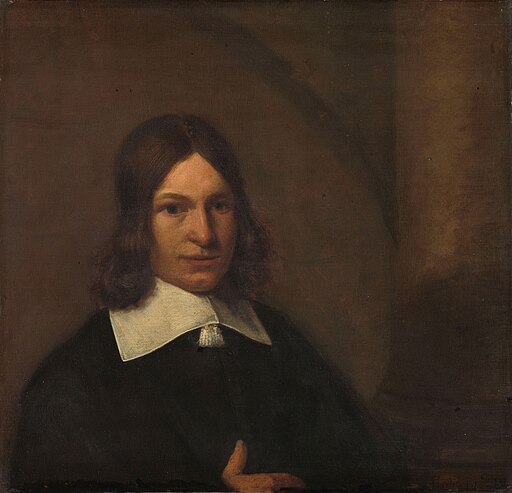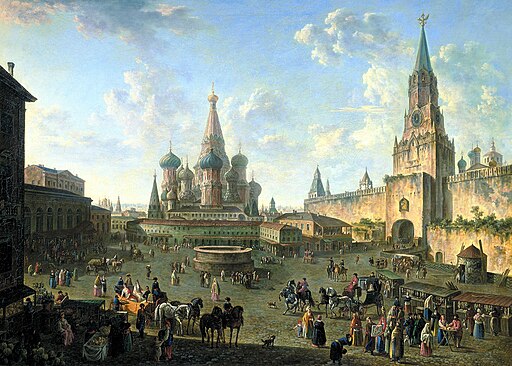
Pieter de Hooch (1629 – 1684) was a Dutch Golden Age painter famous for his works of domestic scenes with an open doorway. He was a contemporary of Jan Vermeer in the Delft Guild of St. Luke, with whom his work shares similar themes and styles.
De Hooch was born in Rotterdam, but little is known of his early life. De Hooch learned to paint from painting instructors who were early members of the Delft School. He became a member of the painters’ guild of Saint Luke in 1655, two years after Vermeer.
The early work of de Hooch was mostly composed of scenes of soldiers and peasants in stables and taverns, during which time he developed skill in light, color, and perspective.
After starting his family in the mid-1650s, he switched his focus to domestic scenes. These paintings were most possibly of his own family.
His work showed close observation of the details of everyday life while also functioning as morality tales.
In the 1660s, he began to paint for wealthier patrons in Amsterdam and is known for merry company scenes and family portraits in opulent interiors.
In his final years, it appears that his distress following the death of his wife caused de Hooch’s painting style to became coarser and darker in color. He died in an asylum in 1684.
A Virtual Tour of Pieter de Hooch
- The Courtyard of a House in Delft
- Dutch Courtyards by Pieter de Hooch
- A Dutch Courtyard
- Drinkers in the Bower
- Dutch Courtyards by Pieter de Hooch
Highlights Tour of Pieter de Hooch
The Courtyard of a House in Delft
“The Courtyard of a House in Delft” by Pieter de Hooch portrays domestic architecture typical of De Hooch’s and Vermeer’s Delft, with building, courtyard, and people engaged in everyday activities.
To the left, an archway entrance of brick and stone leads from a paved courtyard to a passageway through a house, where a woman dressed formally in black and red stands looking away to the street beyond.
To the right is a vine growing over a wooden structure, with an open door through the brick wall to the far right, and a woman leading a child down steps to the courtyard.
This painting is divided into two halves with subtle effects that are at variance with the overall impression of harmony in the composition.
The brickwork of the wall on the right is dilapidated compared to the house on the left. Also, the scene on the right is more chaotic and messy than the left half.
Nature is invading the courtyard on the right with the plant border, the shrubs above the woman and child. The woman on the left looks more formally dressed and is not engaged in meaningful work as she looks to the outside world.
The woman on the right seems to be a servant as she holds a dish in her hand, and a bucket and a broom have been left in the courtyard, while she leads the young child back into the house. Museum: National Gallery, London
Dutch Courtyards by Pieter de Hooch
A Dutch Courtyard
“A Dutch Courtyard” by Pieter de Hooch depicts two men seated at a table in the courtyard and a standing woman. The soldier who is wearing a breastplate is setting down the pitcher he has used to fill the glass, now held by the woman.
The “pass-glass” the woman is drinking from was used in drinking games. Each participant had to drink down to the next line on the glass.
If the drinker failed to reach the line level, the reveler would be required to drink down to the next ring. Only when the drinker had drunk successfully to the required line would the glass be passed on to the next participant.
The little girl carries a brazier of hot coals so that the two soldiers can light their long-stemmed, white clay pipes. Museum: National Gallery of Art, DC
Drinkers in the Bower
Drinkers in the Bower by Pieter de Hooch depicts a view of the back courtyard of a house. The view shows a building, which has an arched passage through it.
A view of the street that is in front of the house is visible through the arched passage. In the foreground at the step of the passage, is seated a child with a dog in her lap.
On the right half of the composition under a covering of vine trellis, are two men sitting at a table. A woman is standing near them with a glass of wine in her hand. Museum: Scottish National Gallery
Dutch Courtyards by Pieter de Hooch
“Courtyard in Delft at Evening: a Woman Spinning” by Pieter de Hooch depicts two women working on their domestic tasks.
The standing figure who is walking from the sunlight into shadow is carrying a jug and a bucket. The seated picture seen in shadow is spinning wool.
This painting is one of De Hooch’s earliest depictions of a courtyard scene, dated 1657, during a time that when De Hooch and Vermeer were both working in Delft.
The viewer is invited to enter what is essentially a private world. Museum: Queen’s Gallery, Buckingham Palace
Pieter de Hooch
- Artist: Pieter de Hooch
- Born: 1629, Rotterdam
- Died: 1684 (aged 54)
- Nationality: Dutch
- Movement: Dutch Golden Age, Baroque
- The Courtyard of a House in Delft
- Dutch Courtyards by Pieter de Hooch
- A Dutch Courtyard
- Drinkers in the Bower
- Dutch Courtyards by Pieter de Hooch
Pieter de Hooch: A collection of paintings
Delft School of Painting
The Delft School of Painting is a category of mid-17th-century Dutch Golden Age painting named after its home base, Delft.
It is best known for images of domestic life, views of households, church interiors, courtyards, squares and the streets of that city.
The Delft School of the Painting was made famous by Pieter de Hooch and Johannes Vermeer.
Besides the genres most closely associated with Delft painters, artists in the city continued to produce still life and history paintings, portraits for patrons and decorative pieces of art that reflected the general tendencies in Dutch art of the period.
From Rembrandt to Vermeer
A Tour of Artists
- Duccio (1255 – 1319)
- Sandro Botticelli (1445 – 1510)
- Leonardo da Vinci (1452 – 1519)
- Albrecht Durer (1471 – 1528)
- Michelangelo (1475 – 1564)
- Raphael (1483 – 1520)
- Titian (1488 – 1576)
- Pieter Bruegel the Elder (1525 – 1569)
- Paolo Veronese (1528 – 1588)
- El Greco (1541 – 1614)
- Caravaggio (1571 – 1610)
- Peter Paul Rubens (1577 – 1640)
- Diego Velázquez (1599 – 1660)
- Rembrandt (1606 – 1669)
- Pieter de Hooch (1629 – 1684)
- Johannes Vermeer (1632 – 1675)
- Canaletto (1697 – 1768)
- Francisco Goya (1746 – 1828)
- Caspar David Friedrich (1774 – 1840)
- J.M.W. Turner (1775 – 1851)
- Jean-Auguste-Dominique Ingres (1780 – 1867)
- Eugène Delacroix (1798 – 1863)
- John Everett Millais (1829 – 1896)
- Frederic Leighton (1830 – 1896)
- Edgar Degas (1834 – 1917)
- Paul Cézanne (1839 – 1906)
- Claude Monet (1840 – 1926)
- Pierre-Auguste Renoir (1841 – 1919)
- Henri Rousseau (1844 – 1910)
- Mary Cassatt (1844 – 1926)
- John William Waterhouse (1849 – 1917)
- Vincent van Gogh (1853 – 1890)
- John Singer Sargent (1856 – 1925)
- Tom Roberts (1856 – 1931)
- Lovis Corinth (1858 – 1925)
- Georges Seurat (1859 – 1891)
- Gustav Klimt (1862 – 1918)
- Edvard Munch (1863 – 1944)
- Henri de Toulouse-Lautrec (1864 – 1901)
- Rupert Bunny (1864 – 1947)
- Wassily Kandinsky (1866 – 1944)
- Franz Marc (1880 – 1916)
- Goyō Hashiguchi (1880 – 1921)
- Amedeo Modigliani (1884 – 1920)
- Artists and their Art
Pieter de Hooch in Delft: From the shadow of Vermeer
Pieter de Hooch
~~~
“He who tends to his own garden does not see the weeds of his neighbors.”
– Dutch Proverb
~~~
Photo Credit: 1) Attributed to Pieter de Hooch [Public domain]
Popular this Week








 Sponsor your Favorite Page
Sponsor your Favorite Page SEARCH Search for: Search Follow UsJoin – The JOM Membership Program
Sponsor a Masterpiece with YOUR NAME CHOICE for $5
Share this:
- Tweet
